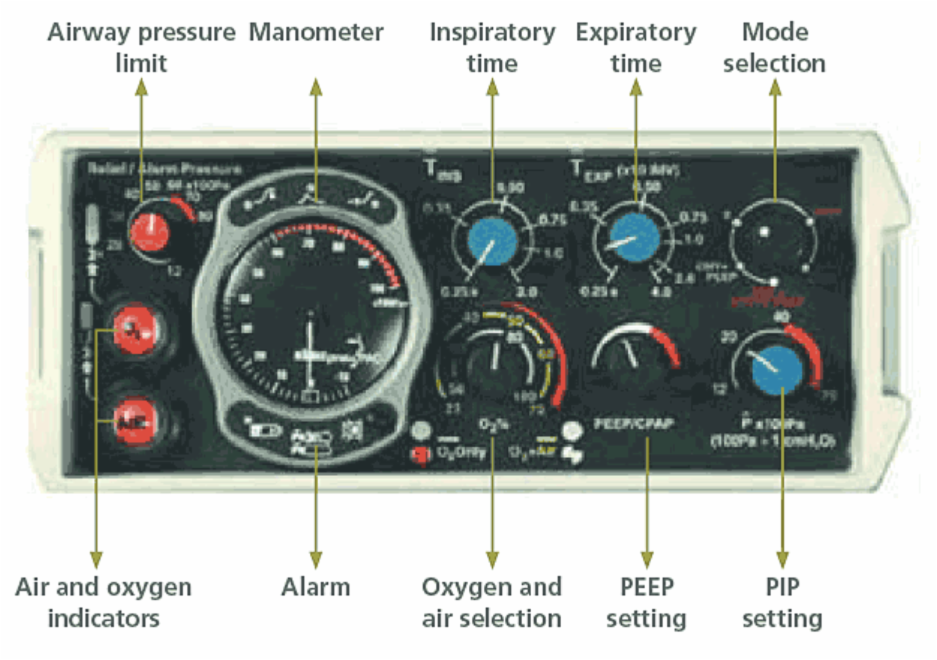- BabyPAC™ is used to ventilate children less than 15 kg. For children more than 15 kg, oxylog 3000/ventipac can be used.
- Ensure the required cables are attached to the babyPAC™. Connect the white
oxygen cable to the wall oxygen or a full oxygen cylinder using the Schraeder
valve. The black air cable does not need to be connected to an air source for
trauma patients. Ensure the ventilator tubing is connected to the babyPAC™
body.
Correct connection of oxygen is indicated on the front panel of the babyPAC™, with a white ball becoming visible as the oxygen cable is connected. - Set the dials on the babyPAC™ ventilator for a sedated and muscle relaxed child. These are starting settings and normally will require adjustment once the ventilator is connected to the patient.

- Set the pressure limit to 30 cm H2O. This does not need to be altered at all.
- Set the inspiratory time to 0.75 second and expiratory time to 2 seconds.
- Set the delivered oxygen to 100%.
- Set the PEEP to 5 cm H2O. This is half way through the white section of the dial. The actual PEEP delivered can be viewed on the pressure dial whilst ventilating the test lung.
- Set the peak inspired pressure (PIP) to 20 cm H2O. The pressure delivered can be viewed on the pressure dial whilst ventilating the test lung.
- Set the ventilator mode to CMV + active PEEP (positive end expiratory pressure), by turning the dial anti-clockwise. The ventilator will now begin cycling. Attach a test lung to check.
Test the ventilator alarms and function.
- Set the ventilator mode to CMV + active PEEP, by turning the dial anticlockwise. The ventilator will now begin cycling and all the alarm lights will flash in turn. A single burst of the high priority audible alarm is given at the same time. The orange silenced indicator should flash for 60 seconds.
- Check that the flow is coming from the patient connection port by feeling the flow when placed close to the back of the hand or face.
- Occlude the proximal connection port of the patient circuit and check that the pressure dial gives a reading between 15–25 cm H2O during each inspiratory phase. The audible alarm should not sound.
- Leaving the high pressure alarm setting at 30 cm H2O, set the inspiratory pressure to 40 cm H2O. Occlude the proximal connection port of the patient circuit and pneumatic audible alarm should sound, accompanied by the high inflation pressure alarm. The pressure dial should read between 25–35 cm H2O. After occlusion for one second, the high priority electronic audible alarm will also sound. Turn the inspiratory pressure back down to 20 cm H2O.
- Allow the ventilator to cycle with no obstruction at the output port and check that the low inflation pressure (disconnect) alarm operates after 8 seconds.
- Connect the babypac ventilator tubing to an HMEF and ETCO2. For children weighing 4 kg–15 kg, connect the babyPAC™ ventilator circuit to the end tidal CO2 adaptor and a small heat moisture exchanger and filter (HMEF). For children weighing less than 4 kg, connect the babyPAC™ ventilator circuit to a heat moisture exchanger and end tidal CO2 adaptor.
- Connect the assembled ventilator circuit to the child’s endotracheal tube. Observe the child’s chest movement and end tidal carbon dioxide trace. Adjust the ventilator settings according to chest movement, end tidal carbon dioxide monitoring and pulse oximetry. Change back to ventilating the child with a self-inflating bag if no chest movement is observed.